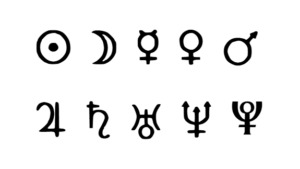
Introduction to Western Astrology:
Western astrology, a system of divination with roots dating back thousands of years, offers profound insights into human nature and the mysteries of life. At its core, Western astrology believes that the positions and movements of celestial bodies, such as planets, stars, and the Moon, hold significant influence over human affairs. Among these celestial entities, the planets play a pivotal role in shaping an individual’s personality, behaviours, and life events. This article serves as an exploration of the planets in Western astrology, their symbolism, energy, and profound significance in birth chart interpretations.
Planetary Symbolism and Energy:
Each planet holds a unique symbolic representation and embodies a specific energy that influences the traits and qualities of individuals born under their influence.
They are not mere astronomical objects but are seen as powerful archetypal symbols representing fundamental aspects of the human experience. Understanding the planets is essential for any astrologer seeking to unlock the secrets of an individual’s birth chart.
For instance, the Sun symbolises the divine spark of life, representing consciousness and individuality. Its energy fosters confidence, creativity, and a sense of purpose. The Moon, on the other hand, signifies the feminine archetype, intuition, and emotions, bestowing nurturing qualities and empathy upon individuals. Mercury’s energy is intellectual, facilitating communication and mental agility, while Venus exudes love, beauty, and the pursuit of pleasure.
The planets’ cycles, as they move through the zodiac signs, create different astrological aspects that shape the individual’s experiences. Planetary aspects are the angles formed between planets and include conjunctions, oppositions, trines, squares, and more, which further refine the interpretations, revealing intricate patterns that shape an individual’s personality and life experiences.
The Planets and Their Categorization:
In Western astrology, there are ten primary planets considered for astrological interpretations.
In traditional Western astrology, the Sun and Moon are considered planets, despite being a star and Earth’s satellite in astronomy. This distinction highlights astrology’s unique perspective, attributing significant astrological importance to these celestial bodies.
Personal Planets
In Western astrology, the personal planets have the greatest impact on our individual personalities. The fastest moving planets, including the Sun, Moon, Mercury, Venus, and Mars, are classified as “personal” due to their influence on our expression as individuals.
The Sun and Moon are referred to as “luminaries,” and play a central role in shaping an individual’s personality and life experiences. Their positions in the birth chart hold primary significance, providing insight into core identity and emotional nature.
Sun: The Sun symbolises the fundamental nature of the individual and the ego. It symbolises consciousness and individuality. The Sun follows an annual cycle, spending approximately one month in each zodiac sign. Its position in the birth chart indicates a person’s fundamental identity, willpower, and desire for recognition. The Sun’s influence is deeply personal, shaping the individual’s self-expression, creativity, and leadership qualities and rules Leo.
Moon: The Moon embodies emotions and instincts. It follows a monthly cycle, spending approximately two and a half days in each zodiac sign. The Moon’s position in the birth chart reveals a person’s emotional needs, nurturing qualities, and instinctual reactions to life events. It represents the subconscious mind and influences how individuals relate to others on an emotional level, and rules Cancer.
Mercury: Mercury represents communication and intellect. Mercury’s time in each zodiac sign is relatively short, around 14 to 30 days. Mercury’s position in the birth chart influences how we think, learn, and express ourselves verbally. It governs logical reasoning, adaptability, and mental agility. Mercury’s influence extends to interpersonal communication, education, and problem-solving. Mercury rules Gemini and Virgo.
Venus: Venus symbolises love, beauty, and harmony. Venus spends approximately 23 to 25 days in each zodiac sign. Venus’ position in the birth chart guides a person’s approach to relationships, aesthetics, and social inclinations. It influences romantic preferences, artistic talents, and the pursuit of pleasure and comfort. Venus rules Taurus and Libra.
Mars: Representing energy and assertiveness, Mars follows a roughly two-year cycle, spending approximately six to seven weeks in each zodiac sign. Mars’ position in the birth chart governs passions, ambitions, and the drive to achieve one’s goals. It influences how individuals assert themselves in the world and deal with challenges and conflicts ruling over Aries and Scorpio.
Social Planets
While the personal planets are typically more immediate and directly experienced in an individual’s life, the social planets tend to have broader and more long-term influences on both personal and collective levels. This is because they have longer orbits and are said to have more impact on how individuals relate to society.
Jupiter: Jupiter represents expansion and growth. It follows a twelve-year cycle, spending approximately one year in each zodiac sign. Jupiter’s position in the birth chart brings luck, opportunities, and a sense of optimism. It influences philosophical pursuits, personal growth, and the desire for exploration and understanding, ruling over Sagittarius and Pisces.
Saturn: Saturn is associated with discipline and responsibility. It follows a twenty-nine-year cycle, spending approximately two and a half years in each zodiac sign. Saturn’s position in the birth chart teaches valuable life lessons, encourages self-discipline, and instils a sense of responsibility and accountability. It influences the areas of life where hard work and perseverance are required for growth and maturity. Saturn rules Capricorn and Aquarius.
Outer or Trans-Neptunian Planets
In Western astrology, the term “outer planets” refers to a group of celestial bodies situated beyond the orbit of Neptune. The primary outer planets include Uranus, Neptune, and Pluto. Moreover, modern discoveries have unveiled other celestial objects like Eris, Haumea, Makemake, Sedna, and more, which are sometimes classified as trans-Neptunian objects (TNOs) or minor planets.
These outer planets were not part of the classical planetary system in traditional astrology. Their discovery came much later, starting with Uranus in 1781, followed by Neptune in 1846, and Pluto in 1930. Their inclusion in astrological interpretations brought about fresh perspectives and deeper insights into the human experience.
These celestial bodies—Uranus, Neptune, and Pluto—are often referred to as “generational planets” in Western astrology. This term emphasizes their influence on entire generations of people, as they spend extended periods in each zodiac sign. Unlike the faster-moving personal planets that have a more immediate impact on an individual’s personality and experiences, the outer or generational planets shape broader and longer-term trends that affect people born within a certain time frame.
Chiron, discovered in 1977, serves as a unique bridge between the inner and outer planets. Initially labelled as asteroid “2060 Chiron,” it later displayed comet-like behaviour. Today, Chiron is recognized as both a minor planet and a comet, earning its place as a captivating hybrid in the outer reaches of the Solar System. In astrology, Chiron is often referred to as the “wounded healer” and is associated with themes of healing, transformation, and the integration of personal wounds into wisdom and strength.
Uranus: Uranus symbolises innovation and rebellion. It follows a cycle of approximately eighty-four years, spending seven years in each zodiac sign. Uranus’ position in the birth chart governs individuality, unconventional thinking, and sudden changes. It brings a revolutionary energy that sparks breakthroughs and the desire for freedom and progress and rules Aquarius.
Neptune: Neptune represents spirituality and imagination. It follows a cycle of approximately 165 years, spending fourteen years in each zodiac sign. Neptune’s position in the birth chart unveils dreams, intuition, and the connection to the mystical and spiritual realms. It influences creative expression, empathy, and the urge to seek deeper meaning in life and rules Pisces.
Pluto: As the planet of transformation and power, Pluto follows a cycle of approximately 248 years, spending anywhere from twelve to thirty-two years in each zodiac sign. Pluto’s position in the birth chart governs profound changes, regeneration, and the exploration of the subconscious mind. It symbolises the depths of human psyche and influences areas of life where profound transformation and empowerment occur and rules Scorpio.
Planetary Influences in Human Experience:
When an individual is born, the positions of the planets at that moment create a unique celestial map known as the birth chart. The planets’ influences extend to various aspects of human experience, including personal, social, and societal realms. Personal influences refer to personality traits and inner motivations, while social influences encompass interactions with others and relationships. Societal influences refer to larger trends and collective phenomena shaped by the outer planets, such as cultural shifts and generational patterns.
Conclusion:
Understanding the planets in Western astrology goes beyond mere astronomical knowledge. Each planet carries symbolic significance and energetic influences that shape an individual’s personality and life experiences. By exploring the planets’ cycles, types, and influences on personal, social, and societal levels, astrologers can provide valuable insights into the complex tapestry of human existence. By analysing the relationships between the planets in the birth chart, astrologers can discern patterns and themes that impact areas such as career, relationships, health, and personal growth. Understanding the planets’ positions and interactions allows astrologers to provide invaluable guidance, aiding individuals in their journey of self-discovery and personal growth.
References
Woolfolk, Joanna Martine. The Only Astrology Book You’ll Ever Need. Taylor Trade Publishing, 2012.
Forrest, Steven. The Inner Sky: How to Make Wiser Choices for a More Fulfilling Life. Seven Paws Press, 2001.
Hickey, Isabel. Astrology: A Cosmic Science. CRCS Publications,1992.
Parker, D., & Parker, J.. The Astrology Book: The Encyclopedia of Heavenly Influences. DK, 2009.
Kent, April Elliott. The Essential Guide to Practical Astrology. Two Moon Publishing, 2016.
Burk, Kevin. Astrology: Understanding the Birth Chart. Llewellyn Publications, 2001.
Hand, Robert. Horoscope Symbols. Whitford Press, 1981.
Greene, Liz. The Luminaries: The Psychology of the Sun and Moon in the Horoscope. Weiser Books, 1984.
Greene, Liz. Saturn: A New Look at an Old Devil. Samuel Weiser, Inc., 1976.
Greene, Liz. The Astrological Neptune and the Quest for Redemption. Weiser Books, 1984.
Notes:
[1] In astrology, the planets represent fundamental principles. The houses, on the other hand, show events, which represent the areas of life or specific life domains, while the zodiac acts as a bridge connecting the planets and houses. Positioned between the planets and the houses, the zodiac unveils the intentions, emotions, and underlying elements within the horoscope.
According to Steven Forrest, “Planets tell us which part of the mind we are looking at (the what). Signs let us know what needs and strategies drive that planet (the why and the how). Houses specify in exactly which of life’s arenas that planet-sign combination is developing (the where)” (The Inner Sky, 2001).
[2] Your astrological sign, also known as your sun sign or zodiac sign, is determined by the position of the sun at the time of your birth. The sun, being the star at the centre of our solar system, spends approximately four weeks in each of the 12 zodiac signs. These zodiac signs and dates are based on the movement of the sun through the sky.
However, it is important to note that these dates are not fixed and may vary slightly depending on factors like leap years, daylight saving time, and time zones. To obtain a more accurate result, you can use a birth chart calculator that considers these factors and provides the exact degree of your sun sign and other planetary placements.

Can the positions of certain planets in our birth chart affect our attitudes towards money, our financial habits, and ultimately our financial success or struggles? Are there specific planetary placements that indicate wealth, financial stability, or financial challenges in a person’s life?”,
“refusal